#diapause
Explore tagged Tumblr posts
Text
Living in a semi-arid region, the African turquoise killifish has developed a handy biological hack to survive months-long droughts that parch its muddy ponds each year. The developing embryos of these thumb-long fish just stop growing – not long after their brain and heart begin to form. For months, they hang out in a state of suspended animation, called 'diapause', to wait out lengthy dry spells. Now scientists have figured out how the African turquoise killifish (Nothobranchius furzeri) manages this drought-defying trick: by co-opting ancient genes buried in its genome that originated more than 473 million years ago.
Continue Reading.
55 notes
·
View notes
Text
Dubious superpowers. Pick one.
A. Sleep like a cuckoo bee. Simply bite on to a branch or parapet of a building & get a solid seven hours in all weather & conditions.
B. Live on nectar. Feel fully energized & get excellent nutrition on a diet of nothing but sugared drinks.
C. Diapause your life. Slow down aging, & metabolism at will during the winter months. You could sleep for days & eat very little with no ill effects.
D. Powerful sting. Sting people you don't like. Boy will it hurt 'em!
#ants#hymenoptera#bee#superpower#poll#my polls#bugs#insects#bugblr#invertebrates#antposting#myrmecology#antblr#bees#beeblr#cuckoo bee#sleep#diapause#sting people#nectar of the gods
188 notes
·
View notes
Text
Merry Christmas, everyone!
A queen Vespula germanica in a deep slumber during the holiday season.
Tiniest tree and presents. Haha.

#hymenoptera#insect#entomology#wasp#wasps#apocrita#cartoon#aculeata#vespidae#vespoidea#vespinae#Vespulagermanica#Queen#Diapause#Winter#Christmas#Sleeping
76 notes
·
View notes
Text
NME | 17 août 2021
Manic Street Preachers : “On s’est guidés dans l’oubli” Nicky Wire et James Dean Bradfield disent à Andrew Trendell comment leur rejet des dissensions a façonné leur glacial et personnel 14ème album, The Ultra Vivid Lament. Continue reading Untitled
View On WordPress
#Augustus John#Blank Diary Entry#Complicated Illusions#Diapause#Don&039;t Let The Night Divide Us#Gwen John#Into The Waves Of Love#Julia Cumming#Manic Street Preachers#Manics#Mark Lanegan#NME#Orwellian#Quest For Ancient Colour#Still Snowing In Sapporo#The Secret He Had Missed#The Ultra Vivid Lament
0 notes
Text
NME | 17 août 2021
Manic Street Preachers : “On s’est guidés dans l’oubli” Nicky Wire et James Dean Bradfield disent à Andrew Trendell comment leur rejet des dissensions a façonné leur glacial et personnel 14ème album, The Ultra Vivid Lament. Continue reading Untitled
View On WordPress
#Augustus John#Blank Diary Entry#Complicated Illusions#Diapause#Don&039;t Let The Night Divide Us#Gwen John#Into The Waves Of Love#Julia Cumming#Manic Street Preachers#Manics#Mark Lanegan#NME#Orwellian#Quest For Ancient Colour#Still Snowing In Sapporo#The Secret He Had Missed#The Ultra Vivid Lament
0 notes
Text
[Image Description: A photo showing test tubes 1/3 filled with water blocked off by a cotton ball to provide humidity to the ants. Each tube contains a queen ant and several workers. The ends are sealed with cotton as these are very young colonies in their period of cloistering. (when the ants rarely leave their nest, often sealing the entrance, as the post indicates they are prepared for their winter diapause) on a neatly cut square of tinfoil the antkeeper has provided each colony with food. The first colony is nearly out of water, but the other two have plenty. ]
(Did you know you can add alt text to your images by clicking the "…" symbol in the lower-left corner of an image? Image descriptions make your posts enjoyable for many more people. Having the description attached to the image is the best way and only the OP can do this, but I also often add descriptions when I reblog cool art and ant stuff. So, if you can't add a description yourself, there are people who will help.)
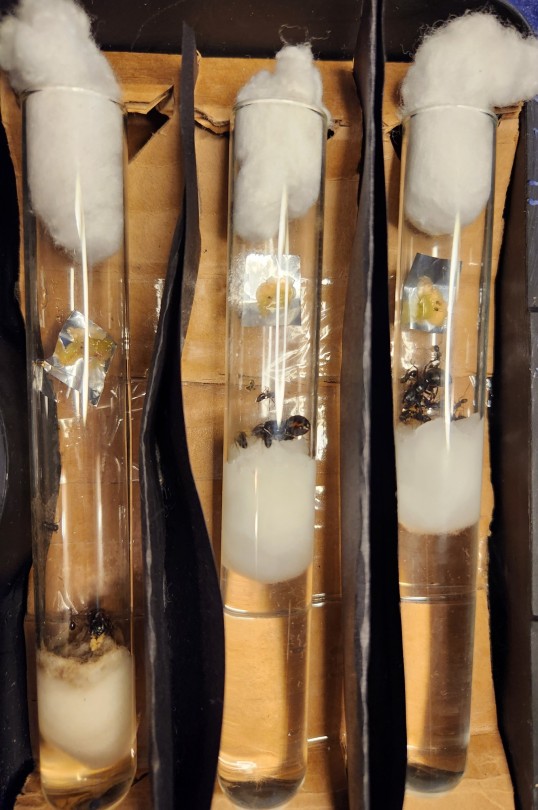
I have awakened the creatures
#ants#antkeeping#carpenter ants#camponotus#diapause#antposting#antblr#bugblr#myrmecology#insects#invertebrates
33 notes
·
View notes
Text
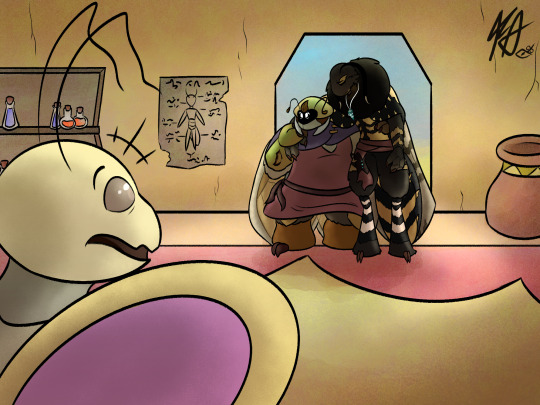
Bugtober 2024- Day 27: Past
A look into one of the first moments after Apollyon was found by Pan. Being a chef and not a medic, Pan rushed them over to Isau as quickly as he could. Apollyon was in a...pretty bad state, but thankfully Isau was able to help it out and Pan was determined to make sure the moth they found ended up okay.
#bug fables#bug fables oc#oc: apollyon#oc: pan#bugtober#Welcome back to Aither rambles about its OCs:#Apollyon wasn't exactly in the best state even before it fled from Wayfarer's Respite. Having to go as far as it went did a number on it.#I say they “fainted” since it gets the point across as a trope but it would be more accurate to say that they went into a state of diapause#They stay in it for a while- even after Pan and Isau helped it- and when they *do* finally wake up they're very confused to be in a house.#Which...is understandable.#Apollyon also very much doesn't trust Pan at first. Also understandable! But maybe not the happiest point in the pair's relationship.#Though Pan making sure Apollyon is fed and safe does wear down the walls it built up and eventually it opens up more to him!#alt text in image#my art
19 notes
·
View notes
Text
If picos school fixation makes me get over my arachnophobia being triggered by pictures of spiders bc I keep having to see them when researching for my penilian designs I will kill someone /silly
#current philosophy is that fc penilians are 'tarantulas with praying mantis body plans that run on cat software' BFKAHSJA#anyway i was thinking about gp and damiotis prompts regarding penilians being coldblooded#not a massive problem bc their home planet is perpetual summer. but come to earth and become like WAY smaller#and suddenly this is a problemVDKAJSKQ#cassandra coming home with the worst brainfog of her life because her body desperately wants to diapause: WHAT KIND OF PLACE IS THIS#💛
9 notes
·
View notes
Text
When I tell you my animal-loving, nerdy, zookeeper brain went BONKERS when Aabria said the phrase “embryonic diapause”, that is not an exaggeration. I exploded in excitement. Not enough people know about this INCREDIBLE trait that so many animals have. What a cool way to try and ensure the survival of a species.
46 notes
·
View notes
Text
[Image Description: The first three photos show a P. Imparis colony living in a test tube. The colony is very healthy probably 100+ workers and lots of brood. These are little brown ants, who live deep underground. Sometimes the workers store food in their gasters which can expand to a large tear drop shape.
You can see the queen who is about twice the size of the workers but still very small. She has a large brown gaster and a dainty head.
The last photo are black carpenter ants living in a cave like formicarium. They have many piles of white eggs which they are cleaning and arranging on the humidity pot. ]
(Did you know you can add alt text to your images by clicking the "..." symbol in the lower-left corner of an image? Image descriptions make your posts enjoyable for many more people. Having the description attached to the image is the best way and only the OP can do this, but I also often add descriptions when I reblog cool art and ant stuff. So, if you can't add a description yourself, there are people who will help.)
So I stuck the P. Imparis colony under my snakes LED light and that did the trick, they moved so fast. Good lighting for photos too ;)
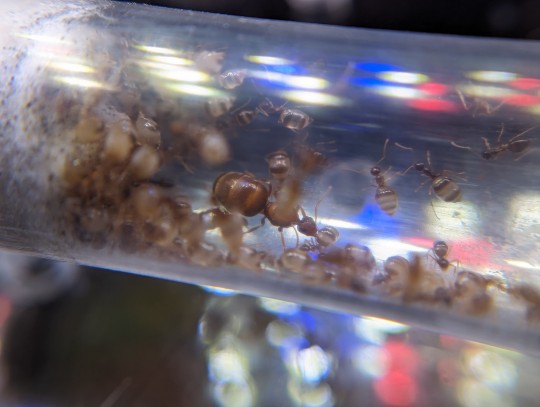
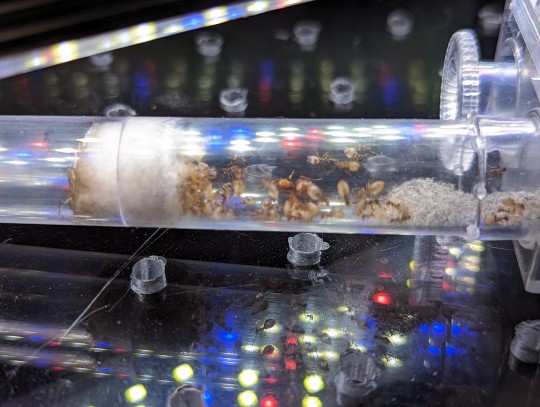

Attempting the same with the C. Subarbatus but they're more stubborn and not in a test tube...
Checked in on my C. Pennsylvanicus colonies too, probably going to fridge the lot of them next week!
Colony 4 has alot of dead inside their nest, they still look fine and queen is well but I don't know why they are dumping their dead in the nest, it's not that over sized for them... Not much I can do though.
Colony 1:
All I can say; "the floor is larva"

These guys are going to need a new nest soon as I take them out of hibernation and all those lil fuckers turn into pupa. They're going to have an EXPLOSION in population!
#camponotus#ant#antkeeping#c.pennsylvanicus#Camponotus pennslyvanicus#antblr#antposting#entomology#insectblr#bugblr#p. imparis#winter ants#carpenter ants#diapause#described
23 notes
·
View notes
Text
so was anyone gonna tell me that some animals form placentas that cover the entire uterus or was i just supposed to learn that during today��s mammalogy lecture
#ecollegy shenanigans#some animals also have placentas that are RINGS#like a placenta ring around the uterus#what the fuck!!!#oh and also marsupials continue to be weirdos in reproduction as well#embryonic diapause goes wild
6 notes
·
View notes
Text
Wet Beast Wednesday: fairy shrimp
It's week 2 of fresh-uary, the month where I only cover freshwater species for Wet Beast Wednesday. This week's entry is on fairy shrimp, who are neither fairies nor shrimp. Instead, they are members of a mostly freshwater group of crustaceans called Branchipods. These little invertebrates are masters at surviving inhospitable conditions and one group has become famous in both the novelty pet and fish food worlds. You may know them as brine shrimp.
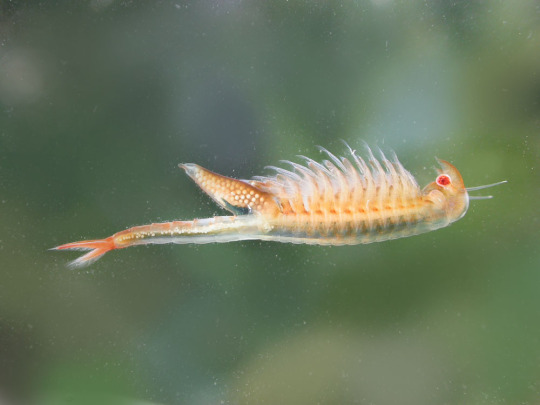
(Image: a female fairy shrimp. It is a small invertebrate somewhat shrimp-like in appearance. It has a large head with a compound eye and two pairs of antennae. The body is long and slender and the front half ans multiple limbs with feathery structures attached to them. The second half ends in a forked tail. This one has a short, transparent egg sac attached to its body just behind the limbs. Small, spherical eggs are visible within. End ID)
Fairy shrimp are members of the family Anostraca, with about 300 known species, many of which are found in very isolated areas. Most species are tiny, maxing out at 6 to 25 mm long, but some species get larger. The largest species, Branchinecta gigas, can reach 170 mm (6.7 in). Being crustaceans, they have exoskeletons, but fairy shrimp exoskeletons are very thin and fragile. The fairy shrimp body plan is divided into three regions, the head, thorax, and abdomen. The head has two compound eyes on stalks, the mouth, and two pairs of antennae. The first pair is long, thin, and unsegmented while the second pair differs depending on sex. Females have a second pair similar to the first pair, while the males have a second pair modified into grasping appendages used to hold onto the female during mating. The thorax is divided into multiple (usually 13 but sometimes more) segments. All but the final two segments are identical and each have a pair of feather-like appendages called phyllopods that act both as swimming limbs and gills. The final two segments of the thorax are fused and have a pair of appendages used for mating. The abdomen consists of 6 segments that don't have appendages. The final segment is the telson, which has a pair of paddle-like structures used for rapid movement and the anus.
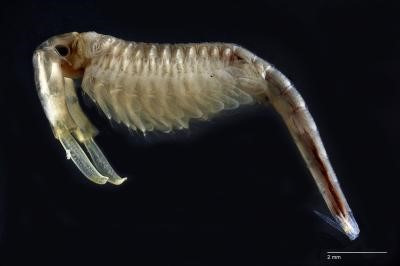
(Image: a male fairy shrimp, identifiable as such by the enlarged and leg-like second pair of antennae. End ID)
Fairy shrimp are graceful, but somewhat slow, swimmers who orient themselves belly-up and swim by moving their phyllopods in sequence. They primarily feed on algae, either by filter feeding or scraping it off of rocks and other submerged structures. Some of the larger species are predators of zooplankton and Branchinecta gigas is a hunter of smaller fairy shrimp. Fairy shrimp are found in inland water on all 7 continents. They specialize in seasonal pools and salt lakes. These harsh conditions make fairy shrimp experts as surviving where many other animals cannot. They have a high tolerance for salinity, heat, and low levels of oxygen, all of which help them survive in salt lakes and evaporating pools. A characteristic all fairy shrimp share is the ability for their eggs to enter a state called diapause. This is a form of cryptobiosis where the egg becomes a cyst that stops growth and metabolic activity. Their development effectively pauses until the proper conditions occur and biological activity resumes. Cysts can survive complete dessication, freezing, hypersaline conditions, UV radiation, and the vacuum of space and can remain in this condition for centuries. Diapause also helps the fairy shrimp spread, as their cysts can be carried to new habitat by the weather or other animals.
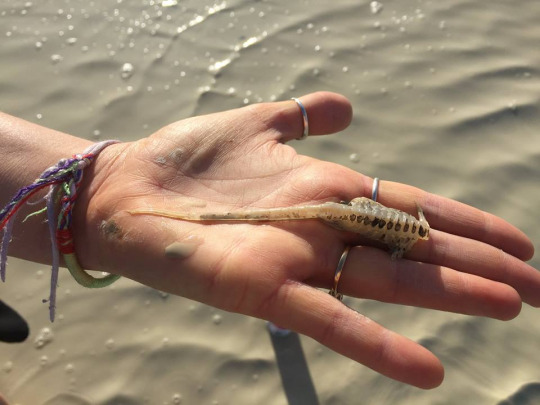
(Image: a giant fairy shrimp Branchinecta gigas held in somebody's hand to show off its size. It is longer than the person's finger and almost as thing in the thorax. End ID)
Fairy shrimp that live in seasonal pools live fast and die young. Their lifespans last a few months at most because they need to develop to maturity and reproduce before the pool dries up for the year. Most species of fairy shrimp have distinct sexes, but some species are exclusively female and reproduce through parthenogenesis. Males use their modified antennae to grab onto females and transfer sperm to her. The female will either carry her eggs on a sac attached to her abdomen or will maintain them internally. Eggs may be released to settle on the sediment or retained internally until the mother dies and sinks to the bottom. Some species will produce two types of eggs. Early season eggs are produced when water is still abundant in the pool. They will quickly hatch and mature to adulthood. Late season eggs are produced when the pool is drying up. They will settle to the sediment and become cysts, waiting for the next wet season to refill the pool before they hatch. Not all cysts will hatch each wet season, some will wait it out for later years. This ensures that a too-short wet season can't wipe out the whole population. Fairy shrimp living in salt lakes generally don't have to worry about their home drying out, but they maintain the ability to encyst their eggs in case the water gets too salty due to evaporation or too cold or hot. Fairy shrimp in salt lakes are vital to their environments because they regulate the population of phytoplankton and bacteria.
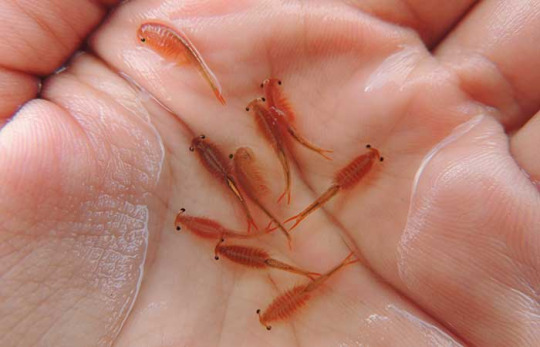
(Image: a close-up of somebody's hand holding some water and 9 red fairy shrimp. End ID)
Fairy shrimp are a major food source to many animals, especially birds. Their isolated or inhospitable habitats keep fairy shrimp safe from many predators, such as fish, but not from birds. Ducks and flamingos are some of the most prominent predators of fairy shrimp. Birds also help spread the shrimp, as the cysts can stick to their bodies or even pass through their digestive systems to be carried to other pools. Humans have also started using fairy shrimp as fish food in aquariums and aquaculture. There is now a multi-million dollar industry based around the Great Salt Lake in Utah and Mono Lake and San Fransisco Bay in California based around harvesting cysts and adult fairy shrimp for sale. The fairy shrimp used in aquaculture are almost all brine shrimp of the genus Artemia. Brine shrimp are also used as model organisms in science and as novelty pets under the brand name of sea monkeys. Brine shrimp cysts are easy to find in many pet and aquarium supply stores and will hatch quickly once exposed to water. Many wild fairy shrimp populations are threatened. Because of how isolated their pools can be, any damage to the pool can endanger the species. Pollution and habitat loss are threatening many species while human-caused movement of fairy shrimp cysts to new pools can lead to them harming native species.

(Image: a magazine advertisement for sea monkeys, featuring a long text listing dubious facts about the animals, an order form, and an illustration of a nuclear family of anthropomorphic sea monkets that look like fish people with three antennae. End ID)
#wet beast wednesday#fairy shrimp#brine shrimp#sea monkeys#crustacean#arthropod#invertebrates#invertiblr#freshwater#freshwater ecology#ecology#zoology#biology#aquaculture#informative#educational#animal facts#image described
127 notes
·
View notes
Text
What if, instead of dealing with winter, everyone just went inside and took some nice long naps in a nice big pile until the cold goes away?
Has anyone ever considered the merit of that plan?
18 notes
·
View notes
Text

Experimental evidence of dispersal of invasive cyprinid eggs inside migratory waterfowl
Ádám Lovas-Kiss, Orsolya Vincze, Viktor Löki, and Balázs András Lukács
Fish have somehow colonized isolated water bodies all over the world without human assistance. It has long been speculated that these colonization events are assisted by waterbirds, transporting fish eggs attached to their feet and feathers, yet empirical support for this is lacking. Recently, it was suggested that endozoochory (i.e., internal transport within the gut) might play a more important role, but only highly resistant diapause eggs of killifish have been found to survive passage through waterbird guts. Here, we performed a controlled feeding experiment, where developing eggs of two cosmopolitan, invasive cyprinids (common carp, Prussian carp) were fed to captive mallards. Live embryos of both species were retrieved from fresh feces and survived beyond hatching. Our study identifies an overlooked dispersal mechanism in fish, providing evidence for bird-mediated dispersal ability of soft-membraned eggs undergoing active development. Only 0.2% of ingested eggs survived gut passage, yet, given the abundance, diet, and movements of ducks in nature, our results have major implications for biodiversity conservation and invasion dynamics in freshwater ecosystems.
Read the paper here:
Experimental evidence of dispersal of invasive cyprinid eggs inside migratory waterfowl | PNAS
#zoology#science#cyprinidae#fish#ichthyology#duck#anatidae#anseriformes#bird#ornithology#animals#nature
203 notes
·
View notes
Text
random spider Peter things cause I just wanna get ideas out there idk
Blue blood
Cant thermoregulate
Hibernation/diapause instincts
Venom glands and fangs
Affected by spider mating season (~autumn)
Hates the smell and taste + semi allergy to spider deterrents such as vinegar, mint, lavender, manufactured deterrents, etc. ⤷ Peter gets warnings from Tony if any experiments in the tower were handling any of the above. Lavender candles are BANNED !!!
Webbing instincts
Has been caught eating bugs. Far too many times
Sorta communication with spiders, thru vibrations. Weak but works
Making the webs himself instead of web fluid and shooters
If someone were to make an Ant-Man-esque tool but for spiders he’d be affected in some way ⤷ cool fic idea where a villain makes the tool and is very happy to learn they can control Spider-Man?
28 notes
·
View notes
Note
Hi! I'd love to hear you yap about train biology/reproduction headcanons! 🚂💜
Just posted this on AO3 but here it is as well:
So as a starting point, Trainfolk are kind of like hermit crabs - they have a humanoid form (what we see in the musical) and a working form (typical rolling stock as we'd see trains in our world). Humanoid forms are roughly human-sized, though they tend to be a bit bigger on average (and engines, especially, would be larger/taller. Rusty is on the small side at just about 7 feet). They're basically able to fuse into their working forms through a process called melding (they sort of melt into it and reform afterwards). Trainlets generally don't meld until they're older, in their early teens usually, but they are technically capable of doing so at a younger age - a trainlet in distress might meld instinctively if there's an empty working form around. Never melding after puberty can start to have a bunch of negative effects, including stunting growth, shorter lifespan, etc. Trains can be distinguished as Engines, Freight or Coaches during pregnancy and generally need to meld with a matching working form. Freight and Coaches can adapt more easily to a different working form; it would take surgery for them to safely meld with an engine or vice versa. Melding for the first time also sets an Engine's fuel type, though this can also be changed via a conversion.
Working forms have three states - melded (trainfolk in there), empty (no trainfolk in there and never has been) and a third state (which I should probably come up with a name for) where a trainfolk has melded but is not currently in there. If a working form goes empty long enough, emergence can occur (it doesn't always). Basically a trainlet unmelds despite having not existed before that point. Usually, this happens with prototypes, but can also happen unintentionally or intentionally. Krupp and Purse are "setting things in motion" by having a security truck working form built with the hopes a trainlet will emerge down the line (Wembley Killerwatt). Pearl was an unintentional emergence and unusually late (at twelve years, when it usually happens around between the first and third year after the working form's build is complete). Emerged trainlets tend to look like at least one person that has an active hand in designing or building them - Electra does resemble both Wrenches despite not sharing any genetics with them.
This happens solely at the Starlight Express's whim (I have it in my mind that they're a real and very active god) but there are scientific hypotheses to the mechanics of it that are yet to be proven. There are also conspiracy theories (elaborate hoax, trainfolks are fey or aliens).
Emergence was more common before there was a substantial trainfolk population but now most trains are born via sexual reproduction. Trains are usually born with one set of reproductive organs or the other (intersex individuals are also possible). Melding allows more fluidity in their humanoid forms though, so a train could replace/grow the other set if they wanted to, but this isn't a super common occurrence. Multiple births tend to be rarer as well and there's no recorded instance of a double emergence from a working form. Wrench is also right about embryonic diapause - basically if conditions aren't optimal for a new trainlet to be born (not enough food/resources, a particularly large/dense population of other trainfolk around) the pregnancy is put on hold until they improve.
Feel free to ask me follow up questions, it's helpful and I will continue to yap :D
32 notes
·
View notes